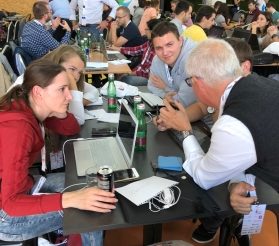Innovation in Banking Demands Supportive Culture from Top Down


Digital transformation requires an innovation structure and foundation or it will not occur. You can’t run a good hackathon just to impress the investment public. Successful innovation projects depend on high-level corporate support, enthusiasm at the company’s grassroots, and a culture that ensures that deserving innovations will move from concept to reality. Otherwise financial creativity will wither.
By Jim Marous, Co-Publisher of The Financial Brand and Owner/Publisher of the Digital Banking Report
Organizations continue to support innovation efforts with everything from innovation labs to hackathons. While such efforts are well received by investment analysts, and are great fodder for senior-level strategic planning meetings and competitive chest thumping, the one thing lacking from many of these efforts is a supportive culture for actually implementing new ideas that are generated.
If these efforts receive top-level support from initiation to implementation, entire organizational cultures can be transformed. An example is a hackathon I just participated in, sponsored by Intesa Sanpaolo, Italy’s leading banking company, in Bratislava. In its third year, the 24-hour Novathon included more than 20 teams working on 6 categories of new solutions.
What stood out about the Intesa Sanpaolo event was the level and breadth of commitment to the process by the entire organization. Heading up the event was Maurice Lisi, Head of Multichannel and Customer Experience at Intesa Sanpaolo. He was one of many senior executives from Italy and across Europe who were very actively involved.
Instead of just showing up for the kick-off and the awards ceremony, as often happens, Lisi attended most of the event, encouraging hackathon competitors and providing helpful direction to the teams. Most importantly, his enthusiasm for the process never waned … it was contagious.
Equally impressive was the support provided by Intesa Sanpaolo employees from across the bank’s wide European network. These highly engaged people traveled from near and far to contribute as mentors, judges, presenters and event concierges, keeping the entire event on track. Clearly these people were honored to be part of the Novathon event, despite giving up an entire weekend.
Development of a Hackathon
Building the Intesa Sanpaolo Novathon has proven to be an excellent way to instill an internal cultural shift that is required to support digital channel transformation. As opposed to being a one-time event, seen internally and externally as only a “feel good” moment, this event was always meant to be an ongoing initiative “sponsored” by different regional headquarters. Setting up the Novathon initiative as an ongoing, well-supported process, turned it into a rallying cry for continued innovation and digital transformation across the entire bank.
The focus of the hackathon has been to proactively address difficult business challenges, such as developing a new product or improving the customer experience on an existing service. As with any innovation process, not every concept developed proved a winner. But the process of generating them provides insights into how the innovation process can be instilled — and a culture changed.
The areas of focus for the Intesa Sanpaolo Novathon were:
- AI for Banking. Exploring new ways to use data and advanced analytics to build personalized relationships with consumers, and to better understand the customer journey inside and outside banking that will positively impact sales and loyalty.
- Biometrics for Security. Ways to use biometrics to provide improved identification and authentication for security and privacy.
- Improved Customer Experience. Developing solutions that are device agnostic, removing friction and improving experiences. Finding the right mix between physical and digital delivery.
- Open Banking and PSD2. Leverage potential of Open Banking & PSD2 to support new customer acquisition and product expansion within a modern banking ecosystem.
- Helping SME Organizations. Finding innovative ways to help businesses work with the bank more effectively, helping them be more successful.
- Personal Financial Management. Develop innovative and interactive functionalities that can help customers improve their financial portfolio.
Focus on the Consumer
The focus of the Intesa Sanpaolo Novathon event was definitely on improving the customer experience. This concentration on new and innovative digital solutions not only created innovations from the hackathon teams, but reinforced the culture that Maurice Lisi and the organization wants to reinforce.
“Everything we will be doing going forward will focus on using data, customer insight and digital technology to improve the customer experience,” stated Lisi. “We need to remove silos and have cross-functional teams work together at the beginning of the innovation process to get things done.”
Rather than setting the Novathon as a standalone weekend event, Intessa Sanpaolo used the opportunity to bring the entire internal team together for a recap meeting and springboard for cultural reinforcement. While many attendees were still a bit tired from the intensity of the previous event, there was no drop in enthusiasm. This opportunity brought the key people from all of the markets together one last time for an inspirational send off. It was also a way to reinforce what needs to be done internally.
REGISTER FOR THIS FREE WEBINAR
Banking on Trust: Employee Advocacy in Financial Services
Globally, financial services rank the lowest of all industries for customer trust according to Edelman research. This is why leading brands are harnessing their collective employee voices instead of corporate channels.
Wednesday, October 31 2:00 PM (ET)
Building Your Own Hackathon
While an organization of any size can create an innovation event, much work is necessary for the event to come off well and to produce a lasting impact. Some of the key learning that came out of my involvement in the Intesa Sanpaolo Novathon:
- Establish well-defined (and relatively narrow) objectives and clear areas of focus. While looking unstructured, the event must be focused to be beneficial over time.
- Ensure high-level organizational support. Otherwise, hackathon teams and support staff will feel their time has been wasted. Remember, the event will fail if it’s just a stunt to impress the investment public.
- Recognize the importance of a large, enthusiastic project team. The number of people involved in the Intesa Sanpaolo event, from team leaders to event concierges, amazed me. Nothing was left to chance. Equally important, clearly, everyone wanted to be at the event, despite it being over a weekend.
- Find a unique location. Why would a bunch of young, aspiring programmers and digital pioneers want to spend a weekend in a bank? Intesa Sanpaolo held its event in a large warehouse-type facility, where events like this often take place. The venue included lounges, game centers, a fully stocked bar, an endless array of food and … most importantly, strong WiFi. While not always perfect, most events boost the power with outside generators.
- Enlist the support of outside sponsors and partners. Such allies not only help defray costs, but can benefit from the innovations created. From industry consultancies to product providers, these organizations had representatives on site to help coach, mentor and provide encouragement.
- Include legal team representation. This is not to place limits on the event, but to provide insight into what may cause challenges if not addressed up front. For the Intesa Sanpaolo event, this person was a high-ranking leader, one of the more enthusiastic members of the support team. The impression left was that this person was an ally, not a threat.
Just because an idea was a winner doesn’t mean it can be easily implemented or functionally possible. Remember, the idea is usually developed in a extremely compressed time frame. The key is to not let the winning ideas die. They need to be tracked and provided adequate support to be successful in the real world. Develop metrics to monitor the idea against the hackathon’s objectives over time.
Finally, understand that innovation events are learning processes. Each one should provide the educational foundation for future events. These are not one-time projects … they are experiences that require ongoing care and support.
Note: My thanks to Maurice Lisi and the team from all of the many Intesa Sanpaolo regional banks who made the 2018 Novathon possible. Your commitment was impressive and your energy infectious.
